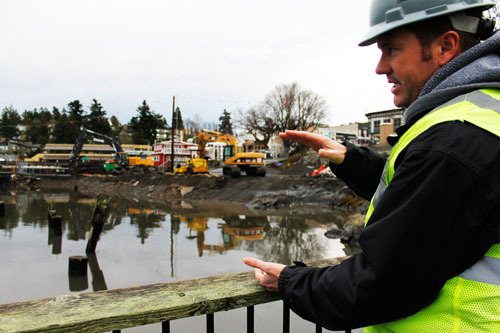As reconstruction of the Port of Friday Harbor marina comes to a close, another project begins.
The bulkhead construction project, at the Spring Street Landing site, is the first phase in what will be a completely revamped public area.
Construction got under way with the excavation of compacted earth that’s acted as a retaining seawall. Once excavation is complete the old piling left over from the former ferry dock, decommissioned in the 1960s, will be removed. The final phase of reconstruction of the bulkhead will be building a new seawall, composed of mechanically stabilized earth that’s reinforced with boulders on the exterior.
According to Port Director Marilyn O’Connor, the current seawall is believed to have been built in the 1960s, when the ferry dock was rebuilt and moved to its current location. The Port didn’t purchase the property until 1982, and the bulkhead was already in place.
“The ground has been settling behind the wall, and the rock face has been failing for many years,” O’Connor said. “The port did an emergency repair of one failed rock section in the late 90s.”
In the public bidding process, local contractor Mike Carlson Enterprises submitted the lowest bid, roughly $1.7 million, to rebuild the entire bulkhead.
Because much of the work needs to be done at seafloor level, Carlson and crew need to take advantage of low tides. This time of year the work window is most often at night.
“Now’s the time,” said port Maintenance Manager Joe Wheeler. “It’s an amazing amount of work in a short period.”
O’Conner said the project required a town shoreline permit, and a U.S. Army Corps of Engineers permit that included environmental and tribal reviews.
Whatever work need to be done in the water must be finished by Feb. 15, to comply with the permit and to protect fish spawning habitat.
“We call this the fish window,” Wheeler said. “It’s not the most desirable time, but it’s necessary. And it’s nice we’re getting it done in the off-season.”
Extra care is being taken at the site, once home to a fuel dock, to minimize environmental impact. The Port is working with Whatcom Environmental, an environmental compliance consultation team, to help with disposal of excavated earth, which could be contaminated with petroleum due to the area’s previous use.
The dirt is stored temporarily while Whatcom Environmental tests it for contaminants, and then advises on its proper disposal.
Essentially, the new seawall will be much like the last–compacted earth faced with rock, and will look similar. However, the south side will be faced with embossed concrete, resembling a vertical, wooden-board texture. Embossed concrete is textured with a pattern to resemble stone, brick, or tile–often used on patios or pool decks.
Eventually, stairs will be built at the site that lead to the water, with an exposed beach at low tide.
The new Spring Street Landing building and waterfront walkway is still in the design phase, and a start date is not yet on the horizon, but the first step is certainly under way. O’Connor said the port hopes to put out a bid for that project in late spring.
“This is definitely a precursor,” Wheeler said. “Once we finish this, we’re off and running.”



